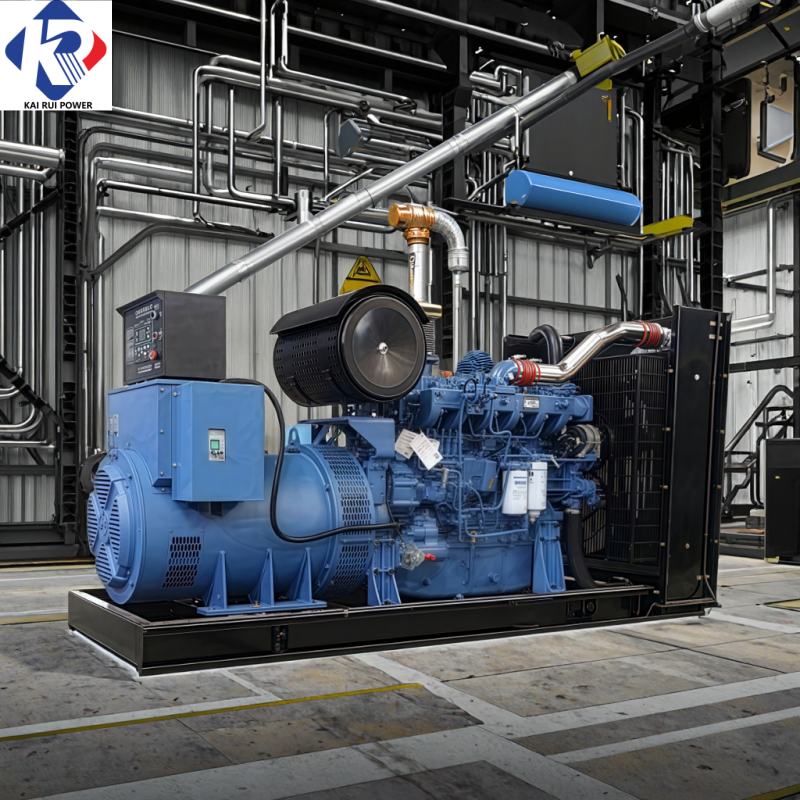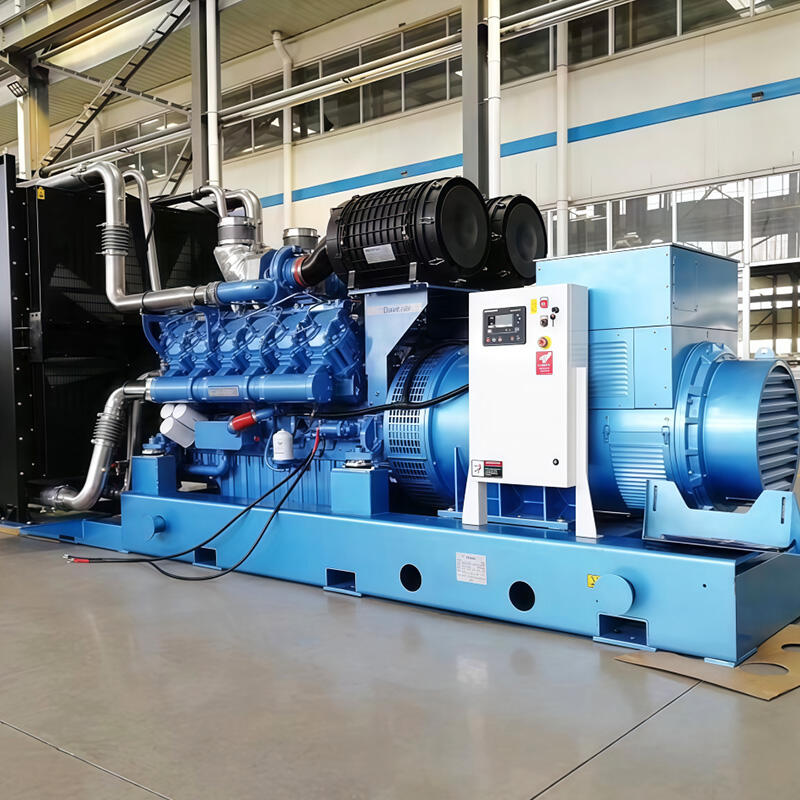Assessing Power Requirements and Correct Generator Sizing
Understanding kVA vs. kW: Key Differences for Industrial Applications
Operators working in industry need to understand the difference between kVA, which is apparent power, and kW, the real power being used, if they want to prevent paying for more than what's actually needed. The kW measurement tells us how much power something really consumes, whereas kVA takes into account those extra demands from things like motors that create reactive power. Take this as an example: when machinery has a power factor around 0.8, it might pull 125 kVA just to get 100 kW worth of useful energy out of it. Getting this wrong can waste up to 20% efficiency in factories according to findings from the Energy Optimization Report released last year. That's why generator sizing should always consider kVA ratings rather than just looking at kW numbers since there are these unseen requirements that affect overall performance.
Peak vs. Continuous Load: Matching Generator Output to Real-World Demands
When it comes to power generation, equipment needs to manage both brief surges in demand (what we call peak load) as well as ongoing operation requirements (continuous load). The truth is, most air cooled systems start struggling after just 8 hours or so under heavy load conditions. Diesel generators on the other hand tend to perform much better in these long running industrial settings where reliability matters most. According to recent industry research published in Industrial Power Trends last year, nearly four out of five unexpected power failures actually happen because the system wasn't sized properly for those occasional peak loads that go beyond 30% of what the generator can normally handle. To avoid this problem, many experienced engineers recommend using load banks during the planning phase. These devices let technicians test how the system will react under extreme conditions before installation, which helps catch potential issues early on.
Risks of Under-Sizing and Over-Sizing: Cost and Operational Impacts
| Factor | Under-Sized Generator | Over-Sized Generator |
|---|---|---|
| Fuel Efficiency | 22% lower due to constant overload | 18% lower from excessive idling |
| Maintenance Costs | $740/hour during forced outages | $310/year from wet stacking |
| Lifespan | 3-5 years (vs. 15-year design) | 12-15 years with frequent derating |
A balanced approach avoids both equipment failure and inflated total cost of ownership (TCO), especially when evaluating generator diesel for sale options requiring precise load alignment.
Generator Duty Types per ISO 8528: Standby, Prime, and Continuous Power Ratings
The ISO 8528 standard defines three critical classifications:
- Standby: ââ¬200 hours/year for emergency outages
- Prime: Unlimited runtime at variable loads (ideal for construction)
- Continuous: 24/7 operation at 100% load (mining/data centers)
Healthcare facilities using standby units for backup typically require 110â130% of peak load capacity, while manufacturing plants relying on prime power need 85â90% load optimization to meet emission regulations.
Comparing Fuel Types: Diesel, Natural Gas, and Dual-Fuel Options
Diesel vs. Natural Gas Generators: Availability, Efficiency, and Total Cost of Ownership
Diesel generators tend to be about 15 to 30 percent more fuel efficient compared to their natural gas counterparts, which makes them a good choice when there's a need for compact power solutions. Natural gas does come out cheaper on a per gallon basis though, but getting the necessary pipelines installed can set back industrial operations anywhere from fifty thousand to two hundred thousand dollars right at the start. We're seeing more facilities go hybrid these days, mixing diesel with natural gas. This approach works well especially in areas with strict emission rules or places where having multiple fuel options matters a lot for day to day operations.
Why Generator Diesel for Sale Dominates Industrial and Backup Power Markets
According to Global Energy Insights from last year, about three quarters of all industrial backup systems still run on diesel. Why? Well, diesel just sits there stable in storage tanks and kicks in right away when the main power goes down. Take a look at the numbers too - diesel packs around forty times more energy per volume compared to compressed natural gas. That means facilities can store much less fuel while getting the same runtime, which is huge for places where every square foot counts. Most industries haven't really switched gears despite newer options coming along. For operations where downtime costs money or even lives, diesel generators are still what people reach for first, though some are starting to question if this will change as regulations tighten up.
Emissions and Environmental Compliance by Fuel Type
The latest Tier 4 compliant diesel engines cut down nitrogen oxide (NOx) emissions by around 90% when compared to what was available before 2015, bringing them much closer to where natural gas generators stand. That said, natural gas continues to produce about half the amount of particulate matter, which makes it easier for companies operating in areas with tough air quality regulations to stay within legal limits. Recent research from combustion labs in 2023 shows something interesting too: dual fuel systems actually perform better regarding emissions because they can switch between different fuels automatically depending on current air quality conditions measured at the site.
Ensuring Electrical Compatibility: Voltage, Phase, and Grid Integration
Selecting the Right Voltage Output for Facility Requirements
Industrial generators must align with facility voltage specifications to prevent equipment damage and operational disruptions. A 2023 NEMA standards analysis found that 38% of generator-related failures stem from voltage mismatches exceeding ±5% tolerance. Facilities requiring high-starting loads, such as motor-driven systems, often need generators with 480V output instead of standard 208V configurations.
| Voltage Class | Typical Applications | Critical Considerations |
|---|---|---|
| 120/208V | Small commercial | Limited to â⬠200 kVA loads |
| 277/480V | Industrial motors | Requires step-down transformers |
| 600V+ | Mining, heavy machinery | Custom switchgear mandatory |
For multi-building campuses, phase converters and digital inverters enable voltage adaptation across infrastructure zonesâa cost-effective alternative to purchasing multiple generators.
Single-Phase vs. Three-Phase Generators: Applications and Compatibility
Three-phase generators dominate industrial settings, delivering 173% more power density than single-phase units while maintaining smoother load transitions. Recent industrial power studies reveal three-phase models achieve 92% efficiency in balanced loads versus 78% for single-phase systems in comparable scenarios.
| Feature | Single-Phase | Three-Phase |
|---|---|---|
| Load Capacity | â⬠25 kVA | 10 kVA â 3,500 kVA |
| Common Use Cases | Retail, residential backup | HVAC systems, CNC machinery |
| Harmonic Distortion | 8â12% THD | <5% THD with ATS integration |
When evaluating generator diesel for sale, prioritize three-phase models with automatic voltage regulators (AVRs) to maintain compatibility with grid-tie inverters and renewable hybrid systems.
Evaluating Reliability, Maintenance, and Long-Term Performance
Run Time Optimization: Fuel Storage and Load Management Strategies
For industrial generators to handle long power cuts, their fuel systems need to be big enough for at least 72 hours straight of running. The 2023 Power Systems Report backs this up pretty clearly. Managing how much load these generators carry is super important too. When facilities start up motors one after another instead of all at once, they avoid overloading the system. This staged approach matters a lot especially where there are lots of motor driven machines around. If companies don't size their fuel tanks properly, they end up needing to refill them way more often during those really long outages. We're talking about a jump of around 40% in refueling trips, which means higher labor expenses and greater chances of getting contaminants into the fuel supply.
Air-Cooled vs. Water-Cooled Generators: Maintenance and Operational Trade-offs
| Feature | Air-Cooled | Water-Cooled |
|---|---|---|
| Maintenance Interval | Every 250 hours | Every 500 hours |
| System Lifespan | 15,000 hours | 22,500 hours (ISO 14001:2023) |
| Cooling Efficiency | 85% at 40°C ambient | 93% in extreme climates |
Water-cooled systems offer 35% longer service life but require antifreeze monitoring and larger installation footprints. Air-cooled units dominate mobile applications due to compact designs, though their fans increase noise levels by 12â18 dB compared to liquid-cooled alternatives.
Key Reliability Metrics: MTBF, Availability, and Failure Rate
Top industrial generators typically reach MTBF ratings well over 65,000 hours these days, according to recent research published in the Journal of Engineering Reliability back in 2024. The availability stats are pretty impressive too, sitting comfortably above 92%. For companies running medium sized operations, even a small boost in generator reliability makes a big difference financially. Just a 1 percent increase in uptime can save roughly $740,000 each year in lost production time, as noted in Ponemon's 2023 industry report. Looking at where problems actually occur is eye opening. Studies show that nearly 58% of unexpected shutdowns come from neglected cooling systems rather than issues with the main engine parts themselves. This highlights how critical regular maintenance really is for keeping operations running smoothly.
Budget, Compliance, and Future-Proofing Your Generator Investment
Total Cost of Ownership: Upfront Price vs. 15-Year Operating Costs
While diesel generators often feature lower upfront costs ($200â$350 per kW), prime power applications require analyzing 15-year operational expenses. Fuel consumption (0.3â0.5 L/kWh for modern diesel units), maintenance cycles, and emission control retrofits can add $740k+ (Ponemon 2023) to total ownership costsâa 3:1 ratio favoring higher-efficiency models despite steeper initial pricing.
Meeting Local Codes, Permits, and Emission Regulations
The industrial generator market has had to adapt to strict regulations from both the EPA's Tier 4 rules and the EU's Stage V requirements. These standards basically force manufacturers to cut down on harmful stuff like nitrogen oxides and particulates by around 90% when compared to older equipment. For companies running non-compliant systems, the financial hit can be serious business - we're talking about average annual penalties hitting around $740,000 for big operations in sectors such as hospitals or power plants. That kind of money adds up fast. Fortunately, newer modular generator setups are starting to incorporate continuous emissions tracking systems right into their design. This makes life easier during those dreaded compliance checks and streamlines the whole permit renewal process. Still, getting all this technology integrated properly remains a challenge for many facility managers dealing with tight budgets and aging infrastructure.
Scalability and Hybrid Trends: Preparing for Load Growth and Modular Expansion
Leading operators are adopting hybrid systems combining diesel generators with battery storage, reducing fuel costs by 40% during peak shaving. Scalable paralleling configurations allow incremental capacity additions (100â500 kW blocks) to match load growth projections without full-system replacementsâcritical as 63% of manufacturers report âÂ¥8% annual energy demand increases (Frost & Sullivan 2025).
FAQ Section
What is the difference between kVA and kW?
kVA is the measure of apparent power which includes reactive power, whereas kW measures real power actually consumed by equipment.
Why are diesel generators more popular for industrial backup systems?
Diesel generators are preferred due to their stability, high energy density, immediate start capability, and lower storage space requirements.
What are the risks of under-sizing a generator?
Under-sizing a generator can lead to higher maintenance costs, lower fuel efficiency, and a reduced lifespan due to constant overload.
How do emissions of diesel generators compare to natural gas generators?
Modern Tier 4 diesel engines have significantly reduced emissions, but natural gas generators still produce fewer particulates.
Table of Contents
- Assessing Power Requirements and Correct Generator Sizing
- Comparing Fuel Types: Diesel, Natural Gas, and Dual-Fuel Options
- Ensuring Electrical Compatibility: Voltage, Phase, and Grid Integration
- Evaluating Reliability, Maintenance, and Long-Term Performance
- Budget, Compliance, and Future-Proofing Your Generator Investment
- FAQ Section






